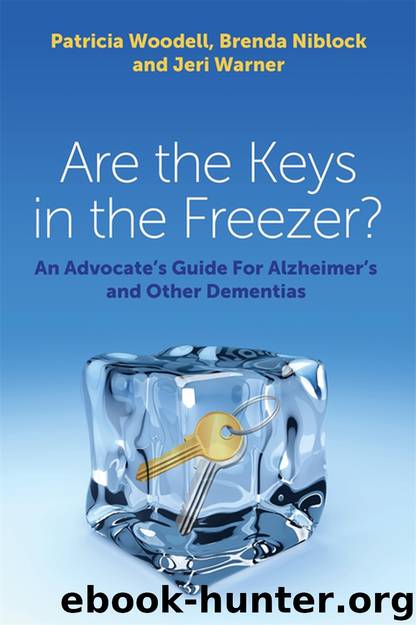Are the Keys in the Freezer? by Patricia Woodell

Author:Patricia Woodell [Patricia Woodell, Brenda Niblock, and Jeri Warner]
Language: eng
Format: epub
ISBN: 9781784501549
Publisher: Jessica Kingsley Publishers
Published: 2015-06-03T16:00:00+00:00
Monitoring a Care Facility’s Medication System
When Mom first moved to assisted living, we were concerned about handing over responsibility for medications to the nursing staff. We had worked hard on perfecting her medication routine and wanted to ensure that it continued seamlessly. Each day, facilities handle medications for several hundred residents, using set management routines to ensure safe delivery, but to make sense of whether these routines are working, it’s critical for families to be familiar with care industry standards. How can we know what a facility is supposed to be doing if we don’t know the rules?
“Best practices” is a term used in many medical settings to describe guidelines or performance standards—in this case, standards for handling medication. Whether a loved one is living at home or in a facility, families can use medication standards to raise their awareness of safe medication practices. The Institute for Safe Medication Practices (ISMP),2 for example, offers detailed guidelines for measuring how medications are handled in a care facility. A few examples of these guidelines include medication storage (security, temperature, labeling), cross-checking for errors, documenting and communicating medical information, and guidelines for staff competencies and training.
Whether in hospitals or care facilities, nurses are key players in ensuring that medications are delivered safely into the hands of seniors. Nurses follow a protocol called the “Five Rights”3 to prevent medication errors. These are: “the right patient, right drug, right time, right dose, and right route.” ISMP is careful to point out that the Five Rights are more than standards; they are actual goals for safe practice in dispensing medications.
A few examples might clarify how the five rights work in practice. In larger settings, like hospitals, patients wear identification bracelets. In other settings, photos may be used to ensure the right patient receives medications or treatment. The right time might include standards for a medication delivery schedule, and the right dose, the system for crosschecking doctor’s orders, prescriptions, and number of pills dispensed. Families whose loved ones use time-sensitive medications should make sure the staff can accommodate schedules that may differ from the facility’s regular medication delivery times.
When previewing care facilities, it is useful to be aware of medication practices that may affect a loved one’s care. The director of nursing or other nursing staff can explain the facility’s safety checks and can offer examples of how they work in practice. In our experience, we think it’s useful to ask specific questions when getting to know a facility’s medication routine.
•Who monitors prescription refills, orders medications from the pharmacy, and determines that prescriptions match doctor’s orders? How are charts documented to ensure that medications are dispensed properly?
•Who calculates doses and administers medications to residents: nurses, medication aides, or both? Must as needed (PRN) medications (aspirin or other low-dose pain medications) be approved by nurses before they are dispensed?
•What safeguards are in place to prevent transcription errors in residents’ medical charts?
•Do medication aides’ training and skill levels match their level of responsibility? Are all caregivers trained to recognize
Download
This site does not store any files on its server. We only index and link to content provided by other sites. Please contact the content providers to delete copyright contents if any and email us, we'll remove relevant links or contents immediately.
Periodization Training for Sports by Tudor Bompa(8171)
Why We Sleep: Unlocking the Power of Sleep and Dreams by Matthew Walker(6618)
Paper Towns by Green John(5092)
The Immortal Life of Henrietta Lacks by Rebecca Skloot(4526)
The Sports Rules Book by Human Kinetics(4295)
Dynamic Alignment Through Imagery by Eric Franklin(4118)
ACSM's Complete Guide to Fitness & Health by ACSM(3989)
Kaplan MCAT Organic Chemistry Review: Created for MCAT 2015 (Kaplan Test Prep) by Kaplan(3940)
Introduction to Kinesiology by Shirl J. Hoffman(3726)
Livewired by David Eagleman(3685)
The Death of the Heart by Elizabeth Bowen(3552)
The River of Consciousness by Oliver Sacks(3542)
Alchemy and Alchemists by C. J. S. Thompson(3451)
Bad Pharma by Ben Goldacre(3357)
Descartes' Error by Antonio Damasio(3230)
The Emperor of All Maladies: A Biography of Cancer by Siddhartha Mukherjee(3068)
The Gene: An Intimate History by Siddhartha Mukherjee(3048)
The Fate of Rome: Climate, Disease, and the End of an Empire (The Princeton History of the Ancient World) by Kyle Harper(3003)
Kaplan MCAT Behavioral Sciences Review: Created for MCAT 2015 (Kaplan Test Prep) by Kaplan(2940)
